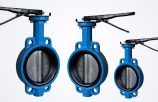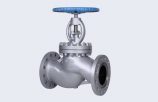Control Valve: How It Works | Advantages & Disadvantages
 secureluokai
secureluokai
 July 14, 2017
July 14, 2017

What is a control valve?
Control valve is used to regulate the fluid flow by changing its size or course as directed by the signal from a controller. It helps in directly controlling the flow rate and thus helps in regulating the other vital processes quantities such as temperature, liquid level/flow, and pressure. It is also refereed as ‘final control element’ in automatic control terminology.
In other words, control valve is used to control the flow, pressure, liquid level, and temperature of the system by completely or partially opening or closing it based on the signals received by the controllers. The electric, hydraulic and pneumatic actuators automatically controls the opening and closing of the control valve while the positioners control the closing and opening of these actuators.
How it works?
The process plant comprises of numerous control loops in order to deliver consistent quality products. These control loops have a set pressure, temperature, flow, level in order to maintain the required operating range. Each of these control loops experience internal disturbance and these disturbances are measured by sensors and transmitters. The information collected is then processed by the controllers to decide what should be done to rectify these load disturbances. Once the data collected is analyzed, measured, compared and calculated then a controlling element is implemented. This is where the control valve comes into the picture and work to reduce these disturbances.
Thus, the control valve working principle revolves around the manipulation of the flowing fluids such as water, gas, steam or chemical compounds to ensure minimizing the load disturbance and regulating the process variable to the closest value of the desired set point.
Values categorization: It’s advantages and disadvantages
On the basis of stem movement, valves can be broadly classified as linear or rotary type. Furthermore, based on the types of services it offers, it can be classified as:
For ON-OFF Services – Gate, Diaphragm Ball, Plug, Butterfly valves.
For THROTTLING Services – Globe, Diaphragm, Butterfly, Pinch
For NON-REVERSE FLOW – Check valves
Gate Valves
Gate valve comprises of flat barrier which is adjusted to effect the area of flow. It is best suited to regulate the high temperature and pressure for variety of liquid flow and has an on-off application. This design or body is used for the valves that manages the automatic emergency shut off and also for the hand-operated valves.
Advantages of Gate Valve
-
- It has a good Closing feature
- Can be used in either ways in circuit
- It provides laminar flow and hence the loss of pressure is minimum
Disadvantages of Gate Valves
-
-
-
- Closing and opening feature is not very prompt.
- Assembling these valves and then erecting it, starting it and maintaining it requires large space.
- Prone to leakage when system operate in high temperature that fluctuates periodically.
- It creates vibration
-
-
Globe Valve
Globe valve is used for throttling purpose and the term ‘globe’ implies to the exterior shape of the valve. The globe valves have a stem that adjusts itself linearly in up-down motion in order to change the position of the plug. It has a short stem travel with high seating capability and large pressure drop and high flow controllability.
Advantages of Globe Valve
-
-
-
- Has a good full closing feature.
- Faster opening and closing time in comparison to gate valve as the strokes are smaller.
- Has a good throttling feature.
- Can work as a stop check valve with little change in shaft disconnection.
-
-
Disadvantages of Globe Valve
-
-
-
- Higher pressure loss in comparison to gate valve.
- It requires actuator that has a larger torque in order to close under high pressure.
-
-
Plug Valves
Plug valve comprises of plug, body, and cover and is used for on-off services basically in refinery, chemical industry, and petrochemical. Normally small in size, require less headroom and available in wide range of materials. They provide tight shut off, quick opening and low pressure drop
-
-
-
- It comprises of few parts and has a simple design.
- Opens and closes easily.
- It can be maintained and repaired easily at the place of operation.
- They have low flow resistance and has a reliable leak-proof feature
-
-
Disadvantages of Plug Valves
-
-
-
- It creates high friction due to fast movement and hence requires large amount of force.
- Valve transitions usually narrows flows due to conic plug.
- Expensive than the ball valves.
-
-
Ball Valves
Ball valve is used to control pressure and flow of the corrosive fluids, normal liquids and gasses and also of slurries. It also regulates high temperature and pressure.
Advantages of Ball Valves
-
-
-
- Offers leak-proof service.
- Fast open and close service.
- In comparison to gate valves has a very small dimension.
- It is light weight in comparison to gate valves.
- Has a multi-way design flexibility to reduce the number of valves required.
- Provides reliable and safe service under high temperature and pressure conditions.
- Requires less force to control in comparison to gate and globe valves.
-
-
Disadvantages of Ball Valves
-
-
-
- Not an apt solution for permanent throttling.
- It can cause leakage, abrasion and more such problems because the residual fluids collide and sticks to the base.
-
-
Diaphragm Valves
Diaphragm valve is used for corrosive fluids under low temperature and pressure conditions. The diaphragm valve varies the resistance to flow by deforming one surface by the force from the valve stem.
Diaphragm Valves Advantages
-
-
-
- The diaphragm completely keeps the working parts in isolation from the process fluids.
- Simple in construction, easier to operate and maintain.
- It has hassle-free operation with simple construction and ease of operation.
- It can be used for opening, throttling, and closing, purposes.
- Based on the internal sheathing of the body, it provides good chemical resistance.
- No shaft leakage as the fluid remains isolated from the bonnet group.
- Suits heavy chemical, chemicals, and radioactive fluids.
- It can prevents microbial contamination to the system as the fluid remains isolated from the bonnet group and thus can be used in food, pharma, and beer sector.
-
-
Disadvantages of Diaphragm Valves
-
-
-
- Complete discharge of the pipeline is prevented as the valve transition has sets.
- Operating temperature and pressure has limits based on the diaphragm material.
- There is a limitation to the hydrostatic pressure that can be applied to the diaphragm.
- It has limited dimensions of diaphragm valves.
-
-
Conclusion:
For more information on various control valves specifically required for your industrial plants / business, Contact Flowspec and we will be happy to answer your questions and give you all the details you need.




